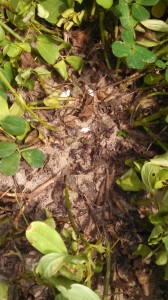It seems to me, just like clockwork, the 3rd and 4th week of July brings white mold (Sclerotium rolfsii) to area peanut fields each year. This year is no exception. We are starting to see leaves and stems “flagging,” giving an indication that stem tissue damage is occurring. Some of our farmers are trying to use the agronomic advantages of night spraying to get chemicals into the crown of the plant for improved control of existing disease. Others are making preventive applications using these methods to get ahead of problems, particularly in light of forecasted rainfall. In this time of high input prices and low commodity prices we need to get maximum benefits from the products we use.
Dr. Bob Kemerait, UGA Extension Plant Pathologist said, “The key to treating white mold is to get the fungicide through the dense leaf canopy onto the crown of the plant and along the limbs. During the daytime, a lot of that fungicide is intercepted by the leaves.” To compensate, growers have to use water or irrigation to attempt to redistribute the fungicide to where it’s most effective. “If peanuts are sprayed at night, the leaves are folded up and you have much more of a direct path to the interior of the plant where you need protection from white mold,” said Kemerait.
However, our local peanut growers learned when we started this practice, that it is also beneficial to return to the field during the day to spray leaf spot products for good leaf coverage, to get the best leaf spot protection possible.



